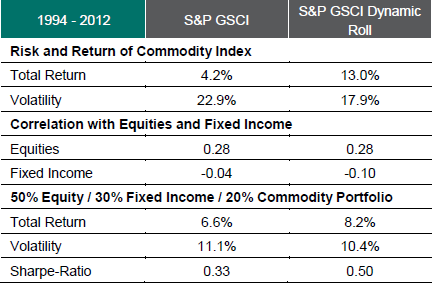Are commodities effective diversifiers for stocks and bonds? In his September 2012 paper entitled “Commodity Investments: The Missing Piece of the Portfolio Puzzle?”, Xiaowei Kang examines the diversification properties of commodity indexes relative to stock and bond indexes. He focuses on the widely used S&P GSCI, composed of 24 commodities with liquid futures markets weighted by world production value. He also considers the S&P GSCI Dynamic Roll, designed to suppress negative roll returns by rolling into longer-dated (nearby) futures contracts when a commodity’s term structure is in contango (backwardation). Using monthly levels of these indexes, MSCI World (to represent stocks) and Barclays Global Aggregate Bond Index (to represent bonds), along with contemporaneous U.S. Treasury bill yields to calculate excess returns, from as early as December 1970 through June 2012, he finds that:
- During December 1972 through June 2012, the correlation between S&P GSCI returns and those for the global equity (bond) index is -0.02 (-0.08). However, these correlations tend to rise sharply during recessions.
- S&P GSCI total return varies considerably by decade, ranging from an annualized 0.8% since the beginning of 2001 to 20.8% during the 1970s. Commodities tend to outperform (underperform) stocks and bonds:
- During the early (latter) part of recessions.
- When inflation is rising (falling).
- Spot price changes explain most of commodity index excess returns at horizons up to a few years, but futures contract roll returns become increasingly important as the horizon grows.
- Driven mostly by differences in roll returns, average returns vary considerably across different commodities and sectors. Volatilities also vary considerably.
- A futures contract roll strategy that considers the term structure (contango or backwardation) can significantly enhance commodities index performance (see the table below). For example, during December 1994 through June 2012, the annualized roll return for the S&P GSCI (S&P GSCI Dynamic Roll) is -6% (+2.3%). However, the dynamic index may have futures contract liquidity and spot price tracking issues.
The following chart, extracted from the paper, compares gross annual total return and diversification statistics for S&P GSCI and S&P GSCI Dynamic Roll during December 1994 through June 2012. The dynamic roll strategy has higher average return and lower volatility, without increasing correlations of returns with world stock and bond indexes. When used for diversification in a portfolio of 50% global equities, 30% global bonds and 20% commodities (via indexes, rebalanced monthly), S&P GSCI Dynamic Roll is a materially better diversifier than S&P GSCI.

In summary, evidence indicates that a broad set of commodities futures, especially when implemented with dynamic rolling based on term structure, has attractive diversification properties with respect to stocks and bonds.
Cautions regarding findings include:
- As noted in paper, investors cannot invest directly in indexes. Calculations with indexes ignore the costs (trading frictions and management fees) associated with creating tradable funds that track them.
- As noted in the paper, strategies designed retrospectively convey the benefit of hindsight (data snooping bias), such that they tend to overstate expected performance.
- As noted in the paper, the relatively low liquidity of long-dated commodity futures contracts may disrupt implementation of a dynamic roll strategy.
- The above asset allocation test ignores the costs of trading each month to maintain target allocations. These costs would reduce reported returns, perhaps differently for the two commodities indexes.